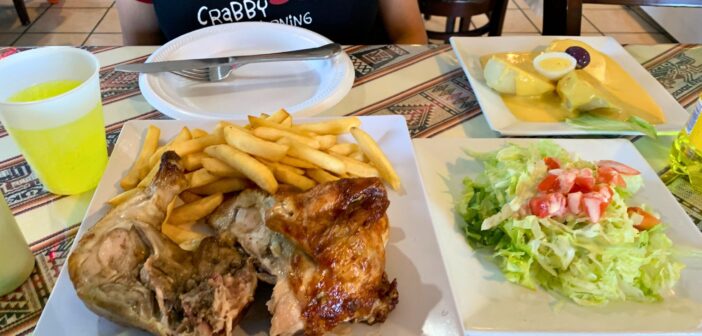I was privileged enough to grow up as an East Coast Peruvian-American who was never more than 20 minutes away from some form of Peruvian food. Needless to say, having a Peruvian restaurant on the outskirts of my stomping grounds has been a huge comfort to me over the last several years.
My three visits to Machu Picchu Peruvian Restaurant, 1330 E 4th St, have done little to disappoint my high expectations.
Upon entry, you’ll often find young kids, big groups and liter sized bottles of Inca Kola across every table.
Flags, jerseys and frames hang across lime green colored walls while over a dozen tables are draped with plastic sheets covering traditional fabrics. They’re paired with unlabelled condiments (presumably ketchup, aji verde and aji amarillo), napkin dispensers and a small vase holding both fake flowers and a table number.
The register counter doubles as a refrigerator filled with house-made chicha morada, mazamorra morada, flan, alfajores, sauces and others.
All of this points to the promise of a prosperous meal. An even better sign? I didn’t hear a lick of English past the door.
Machu Picchu Peruvian Restaurant offers a well-priced offering for all the standard dishes. The menu is family-friendly and the service is fast, even at its busiest of hours. That being said, nothing on the menu is different from what you would find at any other Peruvian restaurant. But for all intents and purposes, that’s perfectly fine with me.
I was interested not only in the quality of the food but also in how it fares against my favorite hole-in-the-walls of New York and New Jersey (no easy feat, considering over 20% of Peruvians in the U.S. live in these two states).
To test its quality, I judged the restaurant on the most standard of dishes: papa ala Huancaina, lomo saltado and pollo ala brasa.
The only appetizer I was concerned with was Papa ala Huancaina: a peasant dish of boiled potatoes smothered with a creamy cheese sauce with subtle nods of garlic, aji amarillo and other spices. As per tradition, it was served with a hard-boiled egg and olive over a bed of lettuce. It came out quickly and would easily accommodate two people (I’ve ordered it each time I’ve brought a date here). The potatoes were perfectly tender and accompanied by the appropriate amount of sauce (A LOT). For someone who’s never tried this, the flavors won’t blow you away. It’s mostly a textural experience with hints of spices, but despite its simple presentation, I was satisfied with a traditional, inoffensive, comforting plate of my favorite appetizer. 8/10.
Although, without claiming to be a rotisserie joint, I would argue their pollo ala brasa is the strongest offering. The menu lets you order between a quarter, half and a whole chicken ($8, $13, $24), each served with french fries and a small salad. This staple in modern Peruvian cuisine is basically just roasted chicken (the magic that elevates it beyond rotisserie chicken is beyond me). This basic menu item is the pinnacle of what most people expect out of a Peruvian restaurant; the idea being that you order a whole chicken for the table. I’ve ordered the ½ size and was content with its size, and Lord, was it delicious. Like the papa ala Huancaina, the spice treatment is mild (making it kid/white person friendly). Juicy, tender, crusted skin is the perfect vehicle for both the house-made white or green sauce sitting on the table. Chicken is a beautiful thing. Pollo ala Brasa is a reminder of that. 10/10.
As good as things have been, Machu Picchu Peruvian Restaurant fails in one major way: lomo saltado. This stirfry of beef, onions, tomatoes and french fries (served with rice too) is not just the pinnacle of Peruvian food, it’s a national treasure. It represents the peak of the cultural infusion of Chinese immigrants discovering the indigenous ingredients of Peru. The flavors of this lomo were not necessarily incorrect, nor was its presentation anything to cause alarm (although, I prefer not to eat cilantro stems for a hefty $17). The meat, however, is where the issue lies. I’ve ordered this twice to make sure this is the case. Unfortunately, the meat was just too tough and unable to absorb the best of the flavors. 6/10.
Chicha morada, a spiced purple corn drink, was another highlight of the dining. The small pitcher is enough to serve 2-4 people and is sipped from disposable plastic cups served to the table. Store-bought chicha (while not bad) is overly sweet, artificially purple and is no match for this house-made refresher. Similarly, the mazamorra morada (the pudding version of chicha) was equally nuanced in flavor, even if the jelly texture isn’t for everyone. (9/10, 9/10).
Bethlehem is full of Latin cuisine. Some of it appeals to college students with Chipotle-style burrito bowl places and upscale “tapas.” Machu Picchu Peruvian Restaurant isn’t trying to be anything but a standard Peruvian-American joint (and for the record, extra french fries are the standard in Peru too).
Don’t let Machu Picchu Peruvian Resutant’s humble demeanor fool you. Its generous servings and robust flavors (although light on heat) are enough to make any mouth water and belly full.






Comment policy
Comments posted to The Brown and White website are reviewed by a moderator before being approved. Incendiary speech or harassing language, including comments targeted at individuals, may be deemed unacceptable and not published. Spam and other soliciting will also be declined.
The Brown and White also reserves the right to not publish entirely anonymous comments.